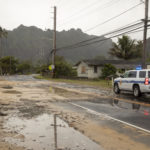
On May 19, 2021, the National Oceanic and Atmospheric Administration announced its outlook for the Central Pacific Hurricane Season, predicting 2-5 tropical cyclcone for the season which begins Tuesday, June 1, 2021 and continues through Nov. 30, 2021.
In a press release Hawaiʻi Emergency Management Agency (HI-EMA) Administrator Luke Meyers, said “Planning for hurricane season can be stressful, but preparing now can keep your family and your home safe. This is the season of high winds and heavy rains, and the damage caused by just an inch of flood water in your home will cost a lot to fix. Flood insurance will help you repair that damage faster. Protect yourself and your family. Visit floodsmart.gov/hawaii today. Each year is a new opportunity to prepare ourselves for the many hazards we face in Hawai`i. Actions we take with our family and friends can help reduce the impacts that will come during this hurricane season.”
The HI-EMA encourages residents to prepare now for a storm that could occur at any time. Below are six actions that have been proven to help people be better prepared during, and after a hurricane:
Action 1: Know your hazards where you live, work, and play – Trees, large loose objects, or other features that can blow over, causing damage to property or injuring a person. Take a moment to look around and know where and what the hazards are including checking to ensure your gas pipes are in good condition and that any potential fire hazards are cleared from the space around your home.
Action 2: Sign up for county alerts – Get up-to-date emergency alerts in your county. More information about alert sign-ups can be found here.
Action 3: Develop a plan for you and your family – Set aside some time to gather with family to create or go over an emergency family plan. Be sure the plan includes things like a safe and acccesible meeting place if you need to reunite, the location of your nearest shelter or hurricane refuge area if you need to evacuate, and a communications plan for how you will let other family members know you are safe. And donʻt forget to be mindful of your family members, pets, and neighbors who may need assistance.
Action 4: Prepare an emergency kit – A good emergency kit will include supplies needed to be on your own for at least two weeks, including the following items.
- Water – One gallon per person, per day.
- Non-perishable food.
- A manual can opener.
- First aid kit.
- Medications and/or special medical equipment such as an inhaler or epi pin.
- A battery-operated or crank radio.
- Extra batteries.
- Flashlight.
- Tools.
- Warm clothes and sturdy shoes.
- Personal hygiene items.
- Toilet paper.
- Pets supplies.
- A fire extinguisher.
- Cash.
- Identification and important documents sealed in water proof plastic bag.
- Masks, gloves, and hand sanitizer.
- Pet supplies.
- Comfort and entertainment items.
- Charging cords for personal electronic devices.
In addition to a 14-day emergency kit, have a go-bag ready for work and your vehicle, including car tools.
Always remember to store potentially dangerous items such as gas or propane tanks in a safe, dry place out of reach of children.
Action 5: Consider flood and/or hurricane insurance – We canʻt control storms, but we can have a little more peace of mind about our property by purchasing insurance.
Action 6: Take steps to strengthen your home against severe weather – Assess and consider a hurricane retrofit or hurricane clips. Protecting your property from the damaging effects of hurricane-force winds and other natural hazards is a proactive way to keep you safer and more resilient.
AP Photo/Eugene Tanner Photographer